I continue with quantum computing exercises from Quantum Katas. In today’s post, I look at the concept of superposition. I’ll use Julia language with Yao quantum computing simulation package for completing exercises.
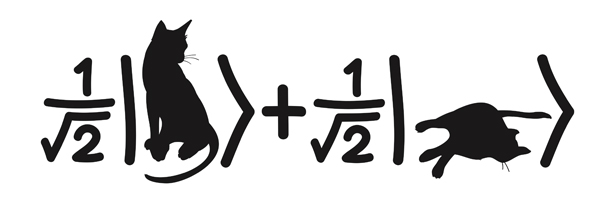
Following katas covers the topics on basic single-qubit and multi-qubit gates, superposition, and flow control.
Table of Contents
- Simple Gates
- Task 1.1. Plus state
- Task 1.2. Minus state
- Task 1.3. Superposition of all basis vectors on two qubits
- Task 1.4. Superposition of basis vectors with phase flip
- Task 1.5. Superposition of basis vectors with phases
- Task 1.6. Bell state $|\Phi^{+}\rangle$
- Task 1.7. All Bell states
- Task 1.8. Greenberger–Horne–Zeilinger state
- Task 1.9. Superposition of all basis vectors
- Task 1.10. Superposition of all even or all odd numbers
- Task 1.11. Superposition of $|0 \dots 0\rangle$ and the given bit string
- Task 1.12. Superposition of two bit strings
- Arbitrary Rotations
- Task 2.1. Unequal superposition
- Task 2.2. $\frac{1}{\sqrt{2}}|00\rangle+\frac{1}{2}|10\rangle+\frac{1}{2}|11\rangle$ state
- Task 2.3. $\frac{1}{\sqrt{3}} \big(|00\rangle + |01\rangle + |10\rangle\big)$ state
- Task 2.4. $\frac{1}{\sqrt{3}} \big( |00\rangle + \omega |01\rangle + \omega^2 |10\rangle \big)$ state
- Task 2.5. Hardy state
using Yao
using SymEngine
using YaoPlots, Compose, Cairo
Simple Gates
Following exercises come from the Multi-Qubit Systems tutorial. This tutorial covers the following topics:
- Vector representation of multi-qubit systems
- Entangled and separable states
- Dirac notation
Task 1.1. Plus state
Input: A qubit in the $|0\rangle$ state.
Goal: Change the state of the qubit to $|+\rangle = \frac{1}{\sqrt{2}} \big(|0\rangle + |1\rangle\big)$.
ket"0" |> H
0.71|0⟩ + 0.71|1⟩
Task 1.2. Minus state
Input: A qubit in the $|0\rangle$ state.
Goal: Change the state of the qubit to $|-\rangle = \frac{1}{\sqrt{2}} \big(|0\rangle - |1\rangle\big)$.
ket"0" |> X |> H
0.71|0⟩ + -0.71|1⟩
Task 1.3. Superposition of all basis vectors on two qubits
Input: Two qubits in the $|00\rangle$ state.
Goal: Change the state of the qubits to $|+\rangle \otimes |+\rangle = \frac{1}{2} \big(|00\rangle + |01\rangle + |10\rangle + |11\rangle\big)$.
ket"00" |> chain(2, put(1=>H), put(2=>H))
0.5|00⟩ + 0.5|01⟩ + 0.5|10⟩ + 0.5|11⟩
Task 1.4. Superposition of basis vectors with phase flip
Input: Two qubits in the $|00\rangle$ sate.
Goal: Change the state of the qubits to $\frac{1}{2}\big(|00\rangle+|01\rangle+|10\rangle-|11\rangle \big)$.
ch = chain(2, put(1=>H), put(2=>H), control(2, 1=>Z))
plot(ch) |> PNG();
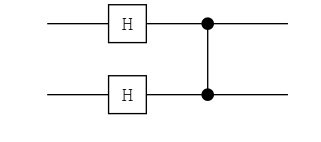
ket"00" |> ch
0.5|00⟩ + 0.5|01⟩ + 0.5|10⟩ + -0.5|11⟩
Task 1.5. Superposition of basis vectors with phases
Input: Two qubits in the $|00\rangle$ state.
Goal: Change the state of the qubits to $\frac{1}{2} \big(|00\rangle + i|01\rangle - |10\rangle - i|11\rangle\big)$.
ch = chain(2, put(1=>H), put(2=>H), put(1=>S), put(2=>Z))
plot(ch) |> PNG();
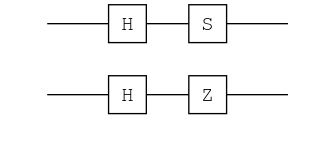
ket"00" |> ch
0.5|00⟩ + 0.5im|01⟩ + -0.5|10⟩ + -0.5im|11⟩
Task 1.6. Bell state $|\Phi^{+}\rangle$
Input: Two qubits in the $|00\rangle$ state.
Goal: Change the state of the qubits to $|\Phi^{+}\rangle = \frac{1}{\sqrt{2}} \big (|00\rangle + |11\rangle\big)$.
ch = chain(2, put(2=>H), cnot(2, 1))
plot(ch) |> PNG();
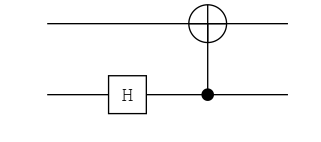
ket"00" |> ch
0.71|00⟩ + 0.71|11⟩
Task 1.7. All Bell states
Inputs:
- Two qubits in the $|00\rangle$ state.
- An integer
index.
Goal: Change the state of the qubits to one of the Bell states.
# State: Φ⁺
ch = chain(2, put(2=>H), cnot(2, 1))
plot(ch) |> PNG();
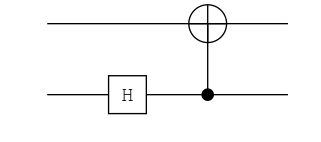
ket"00" |> ch
0.71|00⟩ + 0.71|11⟩
# State: Φ⁻
ch = chain(2, put(2=>H), put(2=>Z), cnot(2, 1))
plot(ch) |> PNG();
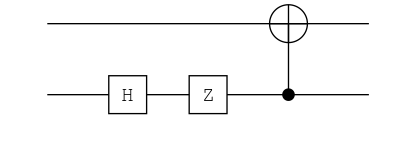
ket"00" |> ch
0.71|00⟩ + -0.71|11⟩
# State: Ψ⁺
ch = chain(2, put(2=>H), put(1=>X), cnot(2, 1))
plot(ch) |> PNG();
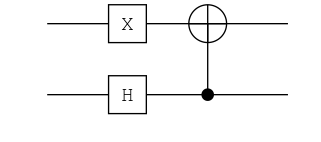
ket"00" |> ch
0.71|01⟩ + 0.71|10⟩
# State: Ψ⁻
ch = chain(2, put(2=>H), put(2=>Z), put(1=>X), cnot(2, 1))
plot(ch) |> PNG();
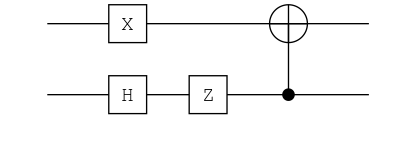
ket"00" |> ch
0.71|01⟩ + -0.71|10⟩
Now put it all together as follows
function bellstates(idx)
ch = chain(2, put(2=>H))
if idx == 2
ch = chain(2, ch..., put(2=>Z))
elseif idx == 3
ch = chain(2, ch..., put(1=>X))
elseif idx == 4
ch = chain(2, ch..., put(2=>Z), put(1=>X))
end
chain(2, ch..., cnot(2, 1))
end
bellstates (generic function with 1 method)
[i => (copy(ket"00") |> bellstates(i)) for i in 1:4]
4-element Vector{Pair{Int64, ArrayReg{2, Basic, SparseArrays.SparseMatrixCSC{Basic, Int64}}}}:
1 => 0.71|00⟩ + 0.71|11⟩
2 => 0.71|00⟩ + -0.71|11⟩
3 => 0.71|01⟩ + 0.71|10⟩
4 => 0.71|01⟩ + -0.71|10⟩
Task 1.8. Greenberger–Horne–Zeilinger state
Input: $N$ ($N \ge 1$) qubits in the $|0 \dots 0\rangle$ state (stored in an array of length $N$).
Goal: Change the state of the qubits to the GHZ state $\frac{1}{\sqrt{2}} \big (|0\dots0\rangle + |1\dots1\rangle\big)$.
ghz(n) = chain(n, put(1=>H), (cnot(1, i) for i in 2:n)...)
ghz (generic function with 1 method)
ch = ghz(3)
plot(ch) |> PNG();
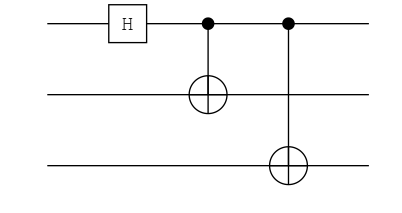
n = 7
zero_state(Basic, n) |> ghz(n)
0.71|0000000⟩ + 0.71|1111111⟩
Task 1.9. Superposition of all basis vectors
Input: $N$ ($N \ge 1$) qubits in the $|0 \dots 0\rangle$ state.
Goal: Change the state of the qubits to an equal superposition of all basis vectors $\frac{1}{\sqrt{2^N}} \big (|0 \dots 0\rangle + \dots + |1 \dots 1\rangle\big)$.
basis(n) = repeat(n, H)
basis (generic function with 1 method)
ch = basis(3)
plot(ch) |> PNG();
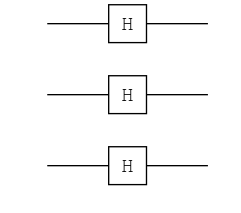
n = 4
zero_state(Basic, n) |> basis(n)
0.25|0000⟩ + 0.25|0001⟩ + 0.25|0010⟩ + 0.25|0011⟩ + 0.25|0100⟩ + 0.25|0101⟩ + 0.25|0110⟩ + 0.25|0111⟩ + 0.25|1000⟩ + 0.25|1001⟩ + 0.25|1010⟩ + 0.25|1011⟩ + 0.25|1100⟩ + 0.25|1101⟩ + 0.25|1110⟩ + 0.25|1111⟩
Task 1.10. Superposition of all even or all odd numbers
Inputs:
- $N$ ($N \ge 1$) qubits in the $|0 \dots 0\rangle$ state (stored in an array of length $N$).
- A boolean
isEven.
Goal: Prepare a superposition of all even numbers if isEven is true, or of all odd numbers if isEven is false.
A basis state encodes an integer number using big-endian binary notation: state $|01\rangle$ corresponds to the integer $1$, and state $|10 \rangle$ - to the integer $2$.
For example, for $N = 2$ and
isEven = falseyou need to prepare superposition $\frac{1}{\sqrt{2}} \big (|01\rangle + |11\rangle\big )$,
and for $N = 2$ andisEven = true- superposition $\frac{1}{\sqrt{2}} \big (|00\rangle + |10\rangle\big )$.
function allEven(isEven, n)
ch = chain(n, repeat(H, 2:n))
isEven ? ch : push!(ch, put(1=>X))
end
allEven (generic function with 1 method)
zero_state(Basic, 3) |> allEven(true, 3)
0.5|000⟩ + 0.5|010⟩ + 0.5|100⟩ + 0.5|110⟩
zero_state(Basic, 4) |> allEven(false, 4)
0.35|0001⟩ + 0.35|0011⟩ + 0.35|0101⟩ + 0.35|0111⟩ + 0.35|1001⟩ + 0.35|1011⟩ + 0.35|1101⟩ + 0.35|1111⟩
Task 1.11. Superposition of $|0 \dots 0\rangle$ and the given bit string
Inputs:
- $N$ ($N \ge 1$) qubits in the $|0 \dots 0\rangle$ state.
- A bit string of length $N$ represented as
Bool[]. Bit valuesfalseandtruecorrespond to $|0\rangle$ and $|1\rangle$ states. You are guaranteed that the first bit of the bit string istrue.
Goal: Change the state of the qubits to an equal superposition of $|0 \dots 0\rangle$ and the basis state given by the bit string.
For example, for the bit string
[true, false]the state required is $\frac{1}{\sqrt{2}}\big(|00\rangle + |10\rangle\big)$.
function BitStringSuperposition(bits)
n = length(bits)
ch = chain(n, put(n=>H), (cnot(n, i) for i in 1:n-1 if bits[i] == 1)...)
zero_state(Basic, n) |> ch
end
BitStringSuperposition (generic function with 1 method)
BitStringSuperposition(bit"10")
0.71|00⟩ + 0.71|10⟩
BitStringSuperposition(bit"101")
0.71|000⟩ + 0.71|101⟩
BitStringSuperposition(bit"10101")
0.71|00000⟩ + 0.71|10101⟩
Task 1.12. Superposition of two bit strings
Inputs:
- $N$ ($N \ge 1$) qubits in the $|0 \dots 0\rangle$ state.
- Two bit strings of length $N$. Bit values
falseandtruecorrespond to $|0\rangle$ and $|1\rangle$ states. You are guaranteed that the two bit strings differ in at least one bit.
Goal: Change the state of the qubits to an equal superposition of the basis states given by the bit strings.
For example, for bit strings
[false, true, false]and[false, false, true]the state required is $\frac{1}{\sqrt{2}}\big(|010\rangle + |001\rangle\big)$.
function TwoBitStringSuperposition(bs1, bs2)
# initialize
n = length(bs1)
@assert n == length(bs2) "Bit string must be of the same length"
qs = zero_state(Basic, n)
ch = chain(n)
# find position of first difference
diff = Yao.BitBasis.baddrs(xor(bs1, bs2))
# apply H gate to corresponding qubit to create superposition
j = 0
if length(diff) > 0
j = first(diff)
push!(ch, put(j=>H))
end
for i in 1:n
if bs1[i] == bs2[i] && bs1[i] == 1
# if two bits are the same, apply X gate
push!(ch, put(i=>X))
elseif i > j
# if two bits are different, set their difference using CNOT gate
push!(ch, cnot(j, i))
bs1[i] != bs1[j] && push!(ch, put(i=>X))
end
end
qs |> ch, plot(ch) |> PNG()
end
TwoBitStringSuperposition (generic function with 1 method)
TwoBitStringSuperposition(bit"0110", bit"1011")
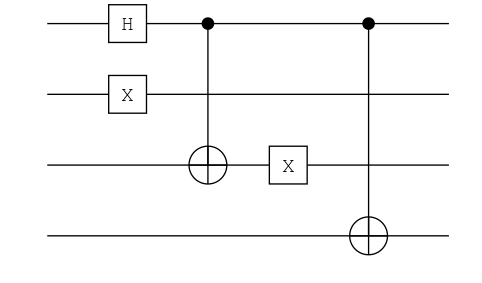
(0.71|0110⟩ + 0.71|1011⟩, false)
Arbitrary Rotations
Task 2.1. Unequal superposition
Inputs:
- A qubit in the $|0\rangle$ state.
- Angle $\alpha$, in radians, represented as
Double.
Goal : Change the state of the qubit to $\cos{α} |0\rangle + \sin{α} |1\rangle$.
α = π/4
0.7853981633974483
cos(α)*ket"0" + sin(α)*ket"1"
0.71|0⟩ + 0.71|1⟩
ket"0" |> Ry(2*α)
0.71|0⟩ + 0.71|1⟩
Task 2.2. $\frac{1}{\sqrt{2}}|00\rangle+\frac{1}{2}|10\rangle+\frac{1}{2}|11\rangle$ state
Input: Two qubits in the $|00\rangle$ state.
Goal: Change the state of the qubits to $\frac{1}{\sqrt{2}}|00\rangle+\frac{1}{2}|10\rangle+\frac{1}{2}|11\rangle$.
ch = chain(2, put(1=>H), control(1, 2=>H))
plot(ch) |> PNG();
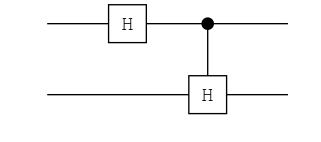
ket"00" |> ch
0.71|00⟩ + 0.5|01⟩ + 0.5|11⟩
Task 2.3. $\frac{1}{\sqrt{3}} \big(|00\rangle + |01\rangle + |10\rangle\big)$ state
Input: Two qubits in the $|00\rangle$ state.
Goal: Change the state of the qubits to $\frac{1}{\sqrt{3}} \big(|00\rangle + |01\rangle + |10\rangle\big)$.
θ₁ = π/4
θ₂ = 2asin(sqrt(1/3))
ch23 = chain(2, put(1=>Ry(θ₁)), put(2=>Ry(θ₂)), put(2=>X), control(2,1=>X), put(1=>Ry(-θ₁)), put(2=>X))
plot(ch23) |> PNG();
ch23 = chain(2, put(2=>Ry(θ₂)), put(2=>X), control(2,1=>H), put(2=>X))
plot(ch23) |> PNG();


ket"00" |> ch23
0.58|00⟩ + 0.58|01⟩ + 0.58|10⟩
1/sqrt(3)*(ket"00" + ket"01" + ket"10")
0.58|00⟩ + 0.58|01⟩ + 0.58|10⟩
Task 2.4. $\frac{1}{\sqrt{3}} \big( |00\rangle + \omega |01\rangle + \omega^2 |10\rangle \big)$ state
Input: Two qubits in $|0\rangle$ state (stored in an array of length 2).
Output: Change the state of the qubits to $\frac{1}{\sqrt{3}} \big( |00\rangle + \omega |01\rangle + \omega^2 |10\rangle \big)$ where $\omega = e^{2\pi i/3}$.
ch24 = copy(ch23) # copy chain from previous exercise (#2.3)
R1(θ) = exp(im * θ / 2) * Rz(θ)
# add the relative phases to both |01⟩ and |10⟩ basis states
# without changing the |00⟩ state
push!(ch24, put(1 => R1(2π/3)))
push!(ch24, put(2 => R1(4π/3)))
plot(ch24) |> PNG();

ket"00" |> ch24
0.58|00⟩ + (-0.29 + 0.5*im)|01⟩ + (-0.29 - 0.5im)|10⟩
ω = exp(im * 2π/3)
1/sqrt(3)*(ket"00" + ω*ket"01" + ω^2*ket"10")
0.58|00⟩ + (-0.29 + 0.5im)|01⟩ + (-0.29 - 0.5im)|10⟩
Task 2.5. Hardy state
Input: Two qubits in the $|00\rangle$ state.
Goal: Change the state of the qubits to $\frac{1}{\sqrt{12}} \big(3|00\rangle + |01\rangle + |10\rangle + |11\rangle\big)$.
θ₁ = 2acos(sqrt(10/12))
ch25 = chain(2, put(2=>Ry(θ₁)))
θ₂ = 2acos(sqrt(9/10))
ch25_2 = chain(2, put(2 => X), control(2,1=>Ry(θ₂)), put(2 => X))
append!(ch25, ch25_2)
ch25_3 = chain(2, control(2,1=>Ry(2π/4)))
append!(ch25, ch25_3)
plot(ch25) |> PNG();

ket"00" |> ch25
0.87|00⟩ + 0.29|01⟩ + 0.29|10⟩ + 0.29|11⟩
1/sqrt(12)*(3ket"00" + ket"01" + ket"10"+ ket"11")
0.87|00⟩ + 0.29|01⟩ + 0.29|10⟩ + 0.29|11⟩